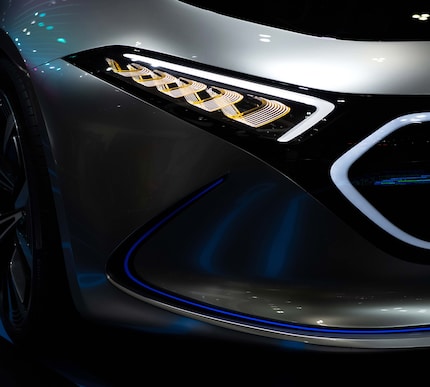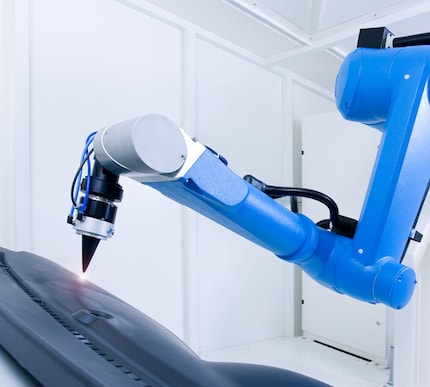- Smart Manufacturing
- Industry 4.0
Design with light for more safety, brand visualization and well-being in the automotive future
“More Light” in vehicle design: light is becoming a key component in vehicle design. Electromagnetic radiation ensures safety, well-being and communication in road traffic. In the same way, the light of the future will make a decisive contribution to the differentiation of automotive brands – and a technology from Jenoptik plays a special role in this.
, Torsten ReichlEffect: The non-verbal power of light

Classic automotive design evokes emotions primarily through shapes. For decades, designers have been transfer-ring human or animal characteristics and appearances to vehicles. A car's attractiveness factors include its facial expression and body language: the headlights serve as the eyes, the radiator grille as the mouth. Its posture is determined by the lines and conveys brand-typical characteristics and values such as sportiness, comfort, safety or elegance. Through its non-verbal expression, the machine takes on essential traits. It seems to express inner moods and symbolizes basic attitudes of relaxation or assertion of power. This and other information about our surroundings reaches the brain through the eyes via light. They form a basis for decision-making.
Light has a strong impact on our well-being, both biologically and emotionally. It controls our internal clock, our hormone balance, our vitamin D production and our body temperature. Depending on this, we feel awake and full of energy, regenerate or sleep. The different wavelengths of light in particular influence how we feel. Red promotes vitality. Yellow lifts the mood. Green regenerates and calms. Blue balances, relaxes and promotes concentration. Cars of the future will evoke these and similar human reactions to colored light in a targeted manner – and, in conjunction with artificial intelligence, presumably also in an individualized way. This use of light effects goes far beyond the currently used warm white light for better visibility in fog or the cold white light to strengthen the driver's ability to concentrate.
Electric driving: Luminous brand profile replaces design language
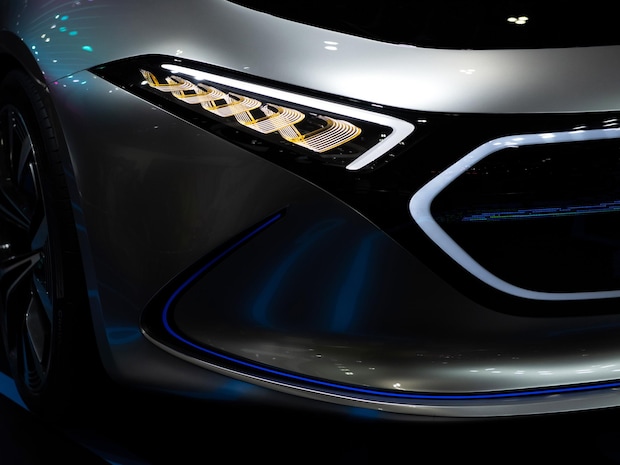
Lighting design is a powerful tool for the creative transfer of information and emotions into visuals.
It is not for nothing that they say that light is the new chrome. Whereas in the past, new collections of chrome-plated cars were launched almost every year, light is not only variable in its shape, color and animation, but can also be personalized. At the same time, lighting design is one of the few remaining distinguishing features of elec-tric vehicle brands. It is becoming the central instrument for distinguishing brands and models from one another and making them recognizable. One reason for this is that equipment and technical standards are becoming in-creasingly similar. On the other hand, the classic and familiar design language of combustion cars is disappearing in favor of a more voluminous use of space for the passenger compartments.
Horsepower gives way to kilowatt hours. This means that large combustion engines, exhaust systems, fuel tanks, pipes and other components of classic vehicles are no longer needed. They create space under the hood and in the passenger compartment. Only a smaller electric motor and the battery system are required for the drive and can be positioned flexibly in terms of space, for example in the floor panel of the electric car. For safety reasons, a sufficient "crumple zone" is maintained. In order to increase energy efficiency and range, manufacturers rely on lightweight materials and aerodynamic shapes, although the latter are only effective outside of purely urban traffic.
Automotive designers have the freedom to fundamentally redesign electric cars based on their changing compo-nents and requirements. However, they are making this change cautiously in order to ensure a smooth transition for habits and brand identities. Light is a central element in this process. One example: electric cars no longer need a radiator grille to ventilate the engine. However, in order to preserve the familiar image of a vehicle for the human eye and to continue to convey the brand's characteristics visually through a non-verbal expression, the shape of the grille is optically recreated using light. Another trend is the "full tail lighting" of rear lights that are con-nected to each other in a single component. Complete light strips that extend from tire to tire are also being im-plemented in the front of the vehicle. Here, safety and design merge into one another. Striking light signatures at the front and rear have become a familiar sight in road traffic. In future, lighting solutions will also convey the vehi-cle attributes in a luminous body design, made possible by translucent surfaces.
Whether a carpet of light, illuminated manufacturer logo or interactive welcome light – beautiful shapes and care-ful staging integrate the character line of the design into the vehicle surface. Illuminated vehicle bodies become an essential feature of differentiation.
Translucent surfaces: Functional light controls autonomous traffic
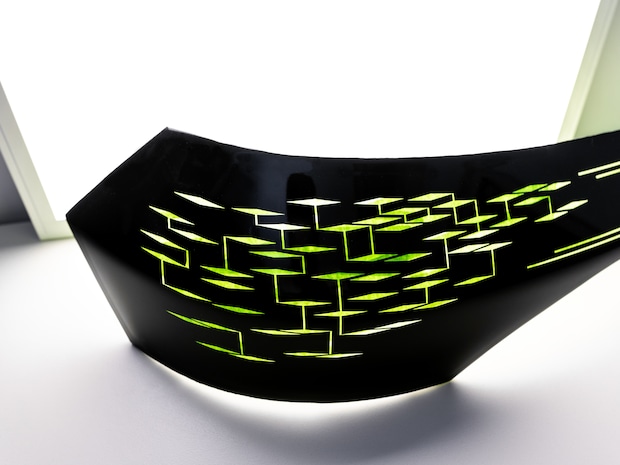
The development of autonomous driving is also bringing new lighting applications with it. Light is becoming a func-tional information carrier. Clear and unambiguous communication between self-driving cars and the people around them is necessary in order for pedestrians, cyclists and autonomous vehicle drivers to move safely and confidently in autonomously dominated road traffic. This can range from light signals such as animated arrows in the bodywork that announce a turning maneuver to a crosswalk projected onto the road that indicates to pedestri-ans that they have been noticed and can cross the road.
Virtual warning symbols, light animations on the vehicle surface and new interpretations for certain light colors in road traffic – light becomes a language between machine and human, so that a vehicle can interact with its envi-ronment. To this end, lighting elements merge with vehicle components, including in what is known as "body shell lighting". The car and its immediate surroundings become a screen for the light signals so that they are not only visible from the front on the radiator grille or from the rear. A large number of light points are integrated into the vehicle components in the form of LEDs and controlled by a complex management system. Ultimately, this also requires definitions of the meaning of the permitted symbols and their colors that are as uniform as possible worldwide.
Interior: Lighting design characterizes the autonomous driving experience
In contrast to the functional aspect of lighting design on the vehicle exterior, the light colors inside the passenger compartment will create an individual driving experience – adapted to the mental, biological and emotional state of the passenger. As a result, the interior of autonomous vehicles in particular is becoming increasingly important. This is where light colors will unfold their full effect, as interior lighting can be individually adapted to taste and mood. Luminous colors balance out moods, reinforce physical and mental target states or simply serve the pur-pose of relaxation or a good mood through "party atmosphere". In addition to the personal preferences of passen-gers, brand messages are also reflected here in order to convey non-verbal characteristics through emotions. This is achieved, for example, through colored mood lighting or dynamic effects such as a twinkling starry sky, passing clouds or even film sequences in the car's headliner.
The light-based applications support the atmosphere and the desired spatial function. As fully autonomous cars no longer require a driver, the usual structure of a passenger cell is no longer necessary. Seats facing the direction of travel give way to the vehicle owner's preferred interior. Be it a sofa facing the TV, a children's room or a fully equipped office workplace – there are virtually no limits to the interior design of autonomous vehicles. Here too, LEDs, when switched off, are invisibly integrated into the surfaces of the vehicle walls in order to use light-based applications for functional or emotional purposes. They can emphasize details, represent the light source of the lighting itself or be used therapeutically.
At present, it remains a vision, but in addition to programmed, automated control, the lighting scene could also be determined by artificial intelligence, which recognizes the emotional and physical state of its passengers based on trained characteristics and adjusts the lighting mood accordingly. Even real plants can also contribute to the de-sired room climate and be optimally supplied with light. In addition to exclusive individual design, visual eye-catchers or the transportation of brand messages, the light in the interior of a vehicle can also create mobile cul-tural experiences. Augmented reality applications for the extended perception of reality or individual immersive exhibitions are technologically feasible, albeit commercially expensive.
Current application: Intelligent light assists on the path to the future
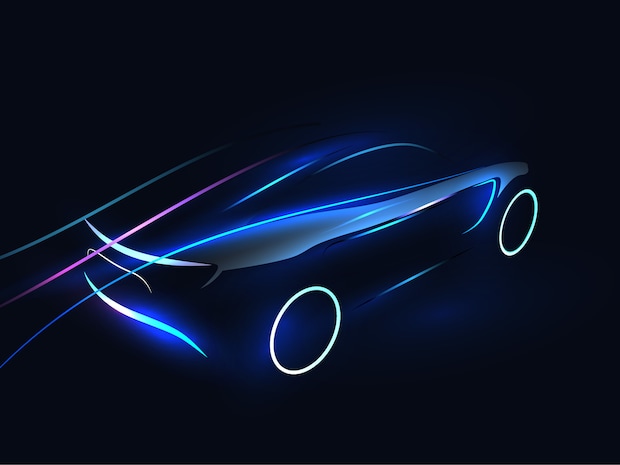
Laser ablation with the translucent technology JENscan® Style
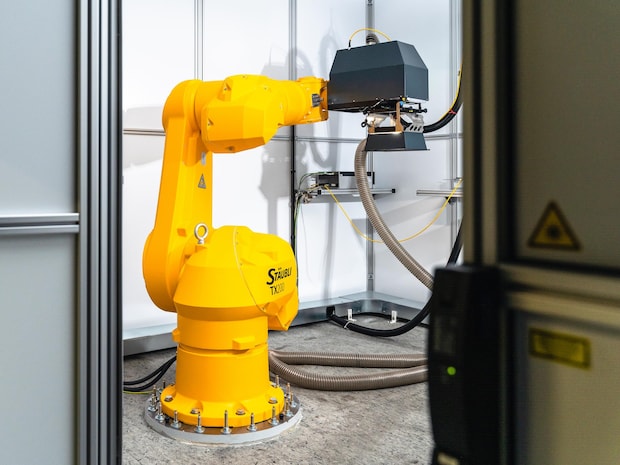
"Lighting design is a development in the automotive industry that, by all indications, will become a basic applica-tion. Car manufacturers in Korea, China, Japan, Europe and the USA are already successfully implementing the trend and creating more and more space for differentiating their brand through light," says Torsten Reichl, Product Manager for the translucent technology JENscan® Style. "The transportation of great emotions has always been the appeal of automotive design. We are very proud to be able to support this global market with our technology. JENscan® Style enables continuous laser ablation of large-format components. This is a technological challenge that our system meets reliably and precisely. We are thus providing automotive designers with a completely new and globally unique level of emotional design with light."
True to its claim "More Light", Jenoptik is supporting the global trends in lighting design in the automotive industry with its translucent technology JENscan® Style. The laser system produces translucent surfaces by removing layers of paint from large-format, three-dimensional plastic components – such as bumpers, tailgates, spoilers, front panels and headliners. Partial paint removal is used for surface backlighting of vehicles for the light integra-tion of design elements and functional lights.
Optical measurement of the components ensures precise laser ablation. The "Active 3D Alignment" function compensates for component fluctuations and ensures reliable precision. Translucent technology is the world's only offering for laser paint removal of large-format automotive components. With this innovation, Jenoptik's Laser Processing unit remains the number one provider of three-dimensional ablation technologies.
About Torsten Reichl
Torsten Reichl has held various positions at Jenoptik since 2007. As Product Manager Laser Processing, he is responsible for the area of laser cutting systems at Jenoptik. Together with his team, he is responsible for the design and development of reliable and efficient laser cutting systems. A particular focus of his work is on the JENscan® Tire, JENOPTIK-VOTAN® BIM and JENOPTIK-VOTAN® S product series.

